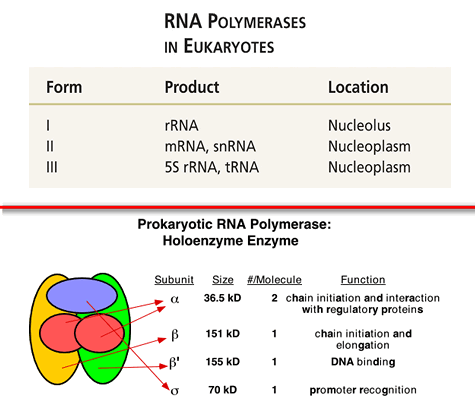
What is RNA Polymerase? is RNA polymerase a protein? Let us read this RNA polymerase and types of RNA polymerase. The RNA polymerases or RNA-polymerized Proteins (RNAP) (or) RNA Pol are a group of proteins with character enzymes capable of forming ribonucleotides to synthesize RNA from a sequence of DNA that serves as a pattern or mold.

The RNA pol involved in the synthesis of messenger RNA or DNA transcription. The RNA polymerase is the enzyme known soluble larger as measured about 100 Å in diameter and is visible in electron micrographs, which notes attached to the promoter DNA.
Table of Contents
RNA Polymerase Definition
RNA Polymerase definition is the synthesis of RNA from a DNA template is called Transcription and is catalyzed by the enzyme RNA polymerase. The enzyme catalyzes the initiation and elongation of RNA chains. RNA Pol is also called “DNA dependent RNA Polymerase“.
The reaction catalyzed by this enzyme is
(RNA)n + Ribonucleoside triphosphate ↔ (RNA)n+1 + PPi
RNA Polymerase Function
What is the function of the RNA Polymerase enzyme? The chemical reaction which catalyzes the RNA polymerase binding is ribonucleotide triphosphate, Adenosine triphosphate(ATP), Uridine triphosphate (UTP), Guanosine triphosphate (GTP) and Cytidine triphosphate (CTP), releasing phosphate groups and turning these nucleotides.
- DNA Replication: Simple Steps of DNA replication in E.Coli
- What is the Fidelity of DNA Replication in Normal?
Besides the polymerization of ribonucleotide triphosphates, RNA polymerase has other functions such as:
- Recognize and bind to specific locations or promoters of the DNA molecule.
- Partially unwinding the DNA template molecule, thanks to its activity helicase intrinsic.
- Synthesizing an RNA primer for further elongation.
- Chain termination.
RNA polymerase function is to catalyze the elongation consecutively RNA chain, while winds and unwinds the double-stranded DNA, and terminates transcription after copying the gene.
RNA Polymerase Structure
This complexity of functions manifested in their Quaternary RNA Polymerase structure, since the DNA polymerase, consists of several subunits that form the holoenzyme, which in conjunction with accessory proteins formed a transcription complex protein machine or conducting the synthesis RNA.
- The Cell – Structure, and Functions (Synopsis Points)
- Structure of Cell Membrane: Basic Guide for Students
Some isolated subunits of RNA polymerase are catalytically functional, while others can only be detected when the transcription complex is fully assembled.
Transcription complexes of different organisms have a variable composition, but essentially all catalyze the same type of reactions.
Due to this coincidence, the study of the transcription process is modeled complex reactions catalyzed transcription of the bacteria Escherichia coli, although it differs in that the assembly of the cell eukaryotic act analogously.
RNA polymerase was discovered while messenger RNA in 1960 by researchers Samuel Weiss and Jerard Hurwitz different laboratories.
There are two different types of RNA polymerase:
- Prokaryotic RNA polymerase
- Eukaryotic RNA Polymerase
Prokaryotic RNA Pol Enzyme
In prokaryotes, the same enzyme catalyzes the synthesis of all types of RNA: mRNA, rRNA, and tRNA. The prokaryotic RNA polymerase is a small molecule.
The RNA Polymerase structure consists of five subunits of approximately (410 Kilo-daltons) α2ββ’ω with two units α identical, that binds DNA non-specifically to catalyze RNA synthesis.

The E.coli polymerase has a tetrameric Core enzyme-containing α-and β-type subunits with the stoichiometry α2ββ’. This is sufficient for transcriptional elongation.
But initiation requires a further subunit termed σ–factor has two functions: it recognizes the promoter and it converts the closed promoter complex.
Once transcription initiated, the σ–factor dissociates from the holoenzyme. The core enzyme can bind to DNA in the absence of σ, but with low efficiency and no specificity.
- Transcription factors: Special Proteins in Transcription
- What is the role of Tertiary Structure of Protein (Basic Guide)
To join specific promoter regions, the holoenzyme requires a σ factor with which greatly reduces the affinity nonspecific DNA regions, increasing specificity promoter regions to form the holoenzyme subunits five α2ββ’σω (~480 kDa).
The structure of RNA polymerase has a groove 55 Å long and 25 Å width.
This slot allows the passage of the DNA double helix is 20 Å. The length can accept 55 to 18 nucleotide sequence.
All units that form the enzyme work together to carry out transcription reactions.
The β-subunit is involved in DNA binding, the β subunit contains part of the active center and the σ subunit is mainly involved in the initiation of transcription and dissociates from the rest of the enzyme after the initiation of transcription.
RNA polymerases from prokaryotic organisms function similarly, although some protein subunit differs in composition.
What about the σ-factor?
A sigma factor (σ factor) is a protein needed only for the initiation of RNA synthesis.
It is a bacterial transcription initiation factor that enables specific binding of RNA pol to gene promoters.
The specific sigma factor used to initiate transcription of a given gene will vary, depending on the gene and on the environmental signals needed to initiate transcription of that gene.
- Gene Silencing: Gene expression regulation at Particular Gene
- What are Gene Families and How they Evolved?
Every molecule of RNA pol holoenzyme contains exactly one sigma factor subunit, which is the model bacterium Escherichia coli is one of those listed below.
The number of sigma factors varies between bacterial species. E. coli has seven sigma factors.
Sigma factors are distinguished by their characteristic molecular weights. For example, σ70 refers to the sigma factor with a molecular weight of 70 kDa.
Specialized Sigma Factors:
Sigma factors in E. coli:
- σ70(RpoD) (or) σA: The “housekeeping” sigma factor or also called as primary sigma factor, transcribes most genes in growing cells. Every cell has a “housekeeping” sigma factor that keeps essential genes and pathways operating. In the case of E. coli and other gram-negative rod-shaped bacteria, the “housekeeping” sigma factor is σ70. Genes recognized by σ70 all contain similar promoter consensus sequences consisting of two parts. Relative to the DNA base corresponding to the start of the RNA transcript, the consensus promoter sequences are characteristically centered at 10 and 35 nucleotides before the start of transcription (–10 and –35).
- σ19 (FecI): the ferric citrate sigma factor, regulates the FEC gene for iron transport
- σ24 (RpoE): the extracytoplasmic/extreme heat stress sigma factor
- σ28 (RpoF): the flagellar sigma factor
- σ32 (RpoH): the heat shock sigma factor, it is turned on when the bacteria are exposed to heat. Due to the higher expression, the factor will bind with a high probability of the polymerase-core-enzyme. In doing so, other heat-shock proteins are expressed, which enable the cell to survive higher temperatures. Some of the enzymes that are expressed upon activation of σ32 are chaperones, proteases, and DNA-repair enzymes.
- σ38 (RpoS): the starvation/stationary phase sigma factor
- σ54 (RpoN): the nitrogen-limitation sigma factor
Eukaryotic RNA Polymerase
Where is RNA polymerase found? In cell eukaryotes, there are three types of RNA pol enzymes, each specializing in a particular RNA synthesis.

- RNA Polymerase I: synthesis, repair, and overhaul. Synthesizes precursors of ribosomal RNA.
- RNA Polymerase II: repair, synthesizes precursors of messenger RNA, microRNAs and other types of ribonucleic acid. This polymerase is the most studied type and required transcription factors that bind to DNA promoters.
- Its three-dimensional structure has been elucidated by Roger Kornberg of Stanford University, who received the Nobel Prize in Chemistry in 2006 for his work. It so happens that this research is the son of another Nobel Prize, Arthur Kornberg, who received the award in 1959 for the discovery of a similar enzyme, DNA polymerase.
- RNA Polymerase III: synthesized transfer RNA, ribosomal RNA, 5S RNA, and other small (ARN proteins) found in the cell nucleus (nuclear pRNA) and in the cytoplasm (cytoplasmic pRNA).
Polymerase IV and V repairs in unique conditions.
- Other RNA Polymerase is in the mitochondrial and chloroplast and nucleus ribosome.
RNA Polymerase in archaea
Archaea has a single RNAP type, responsible for the synthesis of all RNA. The ARNP Archean is mechanically and structurally similar to bacterial RNAP and eukaryotic nuclear RNAP I to V, but especially related to the eukaryotic RNAP II.
You can read more details of RNA polymerase and the types of RNA polymerase.






